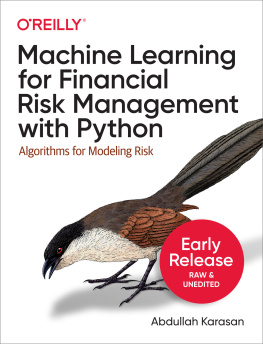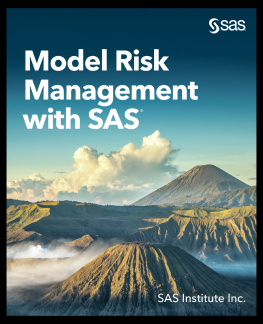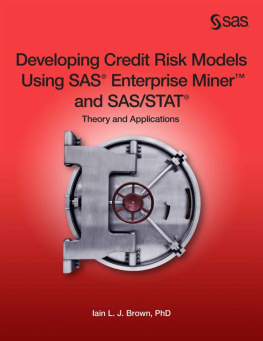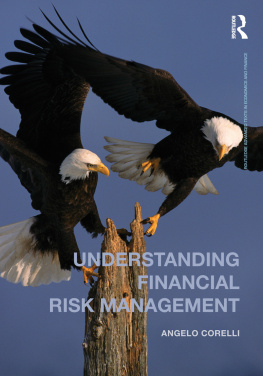Models at Work
Global Financial Markets series
Global Financial Markets is a series of practical guides to the latest financial market tools, techniques and strategies. Written for practitioners across a range of disciplines it provides comprehensive but practical coverage of key topics in finance covering strategy, markets, financial products, tools and techniques and their implementation. This series will appeal to a broad readership, from new entrants to experienced practitioners across the financial services industry, including areas such as institutional investment; financial derivatives; investment strategy; private banking; risk management; corporate finance and M&A; financial accounting and governance; and many more.
Titles include:
Daniel Capocci
THE COMPLETE GUIDE TO HEDGE FUNDS AND HEDGE FUND STRATEGIES
Frances Cowell
RISK-BASED INVESTMENT MANAGEMENT IN PRACTICE (2nd Edition)
Practitioners Guide to the Active Management of Credit Risks
Jawwad Ahmed Farid
MODELS AT WORK
A Practitioners Guide to Risk Management
Guy Fraser-Sampson
INTELLIGENT INVESTING
A Guide to the Practical and Behavioural Aspects of Investment Strategy
Michael Hnseler
CREDIT PORTFOLIO MANAGEMENT
A Practitioners Guide to the Active Management of Credit Risks
Ross K. McGill
US WITHHOLDING TAX
Practical Implications of QI and FATCA
David Murphy
OTC DERIVATIVES, BILATERAL TRADING AND CENTRAL CLEARING
An Introduction to Regulatory Policy, Trading Impact and Systemic Risk
Gianluca Oricchio
PRIVATE COMPANY VALUATION
How Credit Risk Reshaped Equity Markets and Corporate Finance Valuation Tools
Andrew Sutherland and Jason Court
THE FRONT OFFICE MANUAL
The Definitive Guide to Trading, Structuring and Sales
Michael C. S. Wong and Wilson F. C. Chan (editors)
INVESTING IN ASIAN OFFSHORE CURRENCY MARKETS
The Shift from Dollars to Renminbi
Global Financial Markets series
Standing Order ISBN: 9781137327345
You can receive future titles in this series as they are published by placing a standing order. Please contact your bookseller or, in case of difficulty, write to us at the address below with your name and address, the title of the series and the ISBN quoted above.
Customer Services Department, Macmillan Distribution Ltd, Houndmills, Basingstoke, Hampshire RG21 6XS, England
Models at Work
A Practitioners Guide to Risk Management
Jawwad Ahmed Farid


Jawwad Ahmed Farid 2014
All rights reserved. No reproduction, copy or transmission of this publication may be made without written permission.
No portion of this publication may be reproduced, copied or transmitted save with written permission or in accordance with the provisions of the Copyright, Designs and Patents Act 1988, or under the terms of any licence
permitting limited copying issued by the Copyright Licensing Agency, Saffron House, 610 Kirby Street, London EC1N 8TS.
Any person who does any unauthorized act in relation to this publication may be liable to criminal prosecution and civil claims for damages.
The author has asserted his right to be identified as the author of this work in accordance with the Copyright, Designs and Patents Act 1988.
First published 2014 by
PALGRAVE MACMILLAN
Palgrave Macmillan in the UK is an imprint of Macmillan Publishers limited, registered in England, company number 785998, of Houndmills, Basingstoke, Hampshire RG21 6XS.
Palgrave Macmillan in the US is a division of St Martins Press LLC, 175 Fifth Avenue, New York, NY 10010.
Palgrave Macmillan is the global academic imprint of the above companies and has companies and representatives throughout the world.
Palgrave and Macmillan are registered trademarks in the United States, the United Kingdom, Europe and other countries
ISBN: 9781137371638
This book is printed on paper suitable for recycling and made from fully managed and sustained forest sources. Logging, pulping and manufacturing processes are expected to conform to the environmental regulations of the country of origin.
A catalogue record for this book is available from the British Library.
A catalog record for this book is available from the Library of Congress.
To Ammi, Aba & Fawzia.
For all the times when you should have said no, but said yes
Contents
List of Figures
Part I
Part II
Part III
Part IV
Preface
Models at Work
I am not a Quant.
I always wanted to be one but it took a single meeting with Goldmans Firmwide risk team in London to clear any delusions I may have harbored. All remaining reservations were removed in the one PhD finance elective that I took with Maria Vassalou at Columbia. Despite Marias kindness and dedication, it was obvious in April 1999 that I was just an ordinary mortal and not a Quant.
In 1999, the realization wasnt heart breaking. Even if one couldnt live in the exotic world of high finance, the less exalted levels in the banking and trading world offered enough to keep you engaged and happy as a professional.
But that was then. The last six years have shown that the impact of quantitative models travels beyond the inner circle of the more mathematically inclined amongst us. Imagine being a board member at a large bank or a financial institution; imagine the board meeting dossier filled with numbers and graphs that come with no cheat sheet or Rosetta Stone and then envisage the need for you, as a board member, to initial and certify it all with your name and reputation.
The challenge is that armed without a PhD in the subject or years of experience on the trading desk we are hopelessly lost when it comes to dissecting models at work. Even if one wants to learn there is little material available in a language that mortals can understand. The foundation of the field of risk management is based on well-aged sciences of mathematics and statistics. It is but natural that books heavy on mathematical and statistical treatment of the subject are common and abundant, while those relying on simple layperson language and do-it-yourself modeling in EXCEL are not.
Ideally, a book should introduce a framework for managing risk and follow it through with a number of real-world illustrative examples with numbers and data. If you are interested, it should allow you to build and test simple models that you can then use to strengthen your understanding of the conditions under which models can break down or predict where things can go wrong. A great text should educate you enough to not only ask the right questions but also evaluate and digest the answers provided.
Over the last decade, as we put together teaching notes for participants in our workshops for bankers, traders, treasurers and executive MBA students, we found that the above design on teaching risk management worked well. The challenge most professionals face is not with theoretical derivations but with practical applications in the real world.
What is this book about?
The book uses four sections to present frameworks, tools, cases and context around risk management. Here is a quick review of each section:
Part I Risk
A framework for thinking about risk begins with an evaluation of complexity in analysis versus complexity in models. The chapters in this section start with an introduction to dealing with volatility, measuring risk using Value at Risk, managing risk using target accounts and ends with two short chapters on risk policy and risk regulation.
Next page







